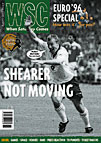 Cathy Cassell describes how Sheffield enjoyed danish company
Cathy Cassell describes how Sheffield enjoyed danish company
For most Sheffielders, memories of Euro ’96 will be tinged with red and white. No-one had predicted the eventual size and impact of the Danish invasion on Sheffield. For two weeks, wherever you went there were there Danes. Danish families following their national team were taking up all the seats in McDonalds and filling the Peak District pubs at dinner time. There were Danish newspapers on the streets, ciggie prices advertised in krona and red and white flags for sale all over town.
These visitors had a series of strange but highly entertaining matchday rituals. Each free kick or corner was greeted with a mass of arms outstretched with fingers waving furiously as if they had just been burned. This was accompanied by mass humming which stopped the moment the kick was taken. The hats with flags on them were impressive too because these were flags with a purpose; flags that could be lowered to half mast when the opposition scored. Perhaps the greatest spectacle of all was that of the 12,000-seater Kop end covered in red and white and singing as one. Though the ultimate nightmare for Wednesdayites, those who experienced it will remember it for a long time to come.
The bizarre free kick ritual was extended to worshipping the clock in the area of the town centre they had made their home. Imagine a vast gang of red and white clad people pointing at your town hall clock and going “Mmmmmmmm”.
Such characteristics endeared Sheffielders towards them. No matter how much lager they consumed, and how badly the team performed, the atmosphere wherever they congregated was nothing short of a party. The city did well out of it. The music festival that was part of ‘Sheffield plays at home’ drew 20,000 people over a weekend, the largest ever for such a festival in Sheffield. Numerous pubs ran dry. The police and council leaders expressed their amazement that such amounts of beer could be consumed by so many football supporters with no trouble at all.
True, there were some that exploited the invasion. Rumours abounded about the alleged £4 a pint on sale only to the red and white, and the flat rate taxi price of a tenner from anywhere in the city to the ground. On matchday I found myself having to pay a quid to enter a pub in Hillsborough. The landlord, later confronted by the local press, assured that any money the bouncers collected was donated to charity. Such exploitation is sad, but perhaps not surprising. We all thought the Danes must be rich. After all, they could afford to buy match tickets, the price of which, at £35-45 was well out of range of most Sheffielders. Ironic that in a city where the game began, in 1857, the locals were denied access to live international football as a result of FA pricing policies. No wonder only 18,000 attended the Denmark v Turkey game.
As their teams weren’t based in Sheffield we saw little of the other three sets of supporters, except on matchdays. There is the now classic story of the Portuguese fan who went into the Sheffield FSA Embassy to ask where the beach was. The Turks, predictably perhaps, failed to live up to any of the menacing stereotypes that preceded them, the Croats still managed to look hard whilst pogo-ing and chanting solidly through each match. But Euro ’96 in Sheffield belonged to the Danes. We’d welcome them back any time.
From WSC 114 August 1996. What was happening this month